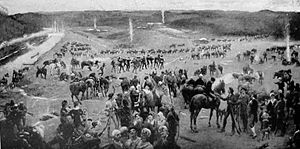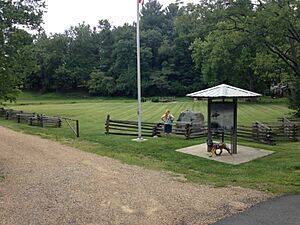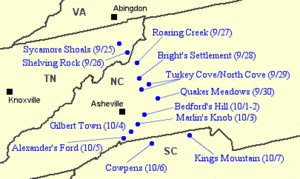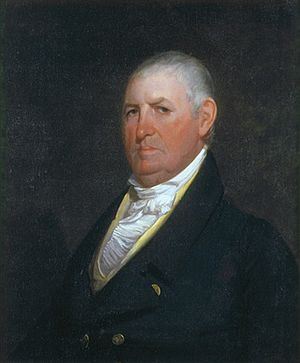Overmountain Men facts for kids
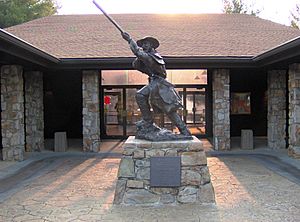
The Overmountain Men were brave American frontiersmen. They lived west of the Appalachian Mountains and fought in the American Revolutionary War. They are most famous for helping the Americans win the Battle of Kings Mountain in 1780.
The name "Overmountain" came from where they lived. Their homes were "over" the Appalachian Mountains. These mountains were a big border between the 13 American colonies and the wild western lands. The Overmountain Men came from areas that are now Virginia, North Carolina, Tennessee, and Kentucky.
Their actions helped protect the new settlements in the Watauga, Nolichucky, and Holston river valleys. The British Crown had questioned if these settlements were allowed. Many Overmountain Men, like John Sevier and Isaac Shelby, later became important leaders. They helped create the states of Tennessee and Kentucky. Their success on the frontier opened the way for many more people to move west later on.
Contents
Early Settlements Over the Mountains
In the late 1760s and early 1770s, European-American settlers moved into what is now northeastern Tennessee and southwestern Virginia. This made the Overhill Cherokee and other Native American tribes upset.
In 1770, the Treaty of Lochaber was signed between the British and the Cherokee. This treaty moved the British border south to Long Island of the Holston (today's Kingsport, Tennessee). This protected settlers north of the Holston River. But settlers south of the river were told to leave.
Instead of leaving, these settlers decided to rent land from the Cherokee. Most of them lived in the Watauga settlement at Sycamore Shoals (near Elizabethton, Tennessee). Others were in the Nolichucky settlement (near Greeneville, Tennessee) and Carter's Valley (near Kingsport). In 1772, they formed the Watauga Association. This was the first independent American government west of the Appalachians. In 1775, the Watauga and Nolichucky settlers bought their rented lands. They then created the independent Washington District. They quickly asked Virginia to make them part of its colony, but Virginia said no.
The British Crown and colonial governments thought these land purchases were illegal. They ordered the settlers to leave what they saw as Cherokee lands. Also, some Cherokee groups became angry as these settlements grew fast. A young Cherokee chief named Dragging Canoe did not want to sell tribal lands. He wanted all European settlers removed from west of the mountains. He led about a thousand followers, known as the Chickamauga Cherokee. They fought against the new country for almost 20 more years. This happened after the Cherokee attacks on the Overmountain settlements failed in 1776.
Fighting in the Revolutionary War
First Battles
When the American Revolution began in 1776, the Overmountain settlers got ready for attacks. Most of them were Whigs, meaning they were against the British king. North Carolina accepted the Watauga Petition, making the Washington District part of that colony. This made the Cherokee even more determined to push the Americans out. The British also encouraged the Cherokee.
The attacks came in July 1776. Settlers were driven out of Carter's Valley and Nolichucky. But the Cherokee were defeated at Eaton's Station on July 20 and at Fort Watauga on July 21. They eventually left the area. North Carolina's revolutionary leaders felt sympathy for the settlers. In 1777, they allowed the Washington District to join the colony equally. This area became Washington County, North Carolina.
The Overmountain Men fought in many battles against British Loyalists and the British-allied Cherokee and Shawnee tribes. These battles took place all along the Appalachian frontier. In 1778, 20 Wataugans helped defend the Boonesborough and Harrodsburg settlements in modern Kentucky. They protected them from Shawnee attacks.
In the summer of 1780, a group of Overmountain Men led by Isaac Shelby joined Colonel Charles McDowell. They raided Loyalist camps in the Piedmont mountain region of northwestern South Carolina. The Overmountain Men captured Fort Thickety and helped the Patriots win at the Battle of Musgrove Mill. However, most Overmountain Men went home for the 1780 harvest season. McDowell stayed behind with a small group to keep fighting Loyalists.
A Call to Arms
After winning the Battle of Camden in August 1780, British General Charles Cornwallis moved into North Carolina. He sent Major Patrick Ferguson into the mountains. Ferguson's job was to find and stop the Patriot fighters and protect the Loyalists. Ferguson quickly defeated McDowell's smaller force. McDowell then retreated across the mountains to the Washington District.
Ferguson let a captured frontiersman named Samuel Phillips go free. Phillips was a cousin of Isaac Shelby. Ferguson sent Phillips with a message to the Overmountain settlements. He warned the Overmountain Men that if they did not stop fighting, he would "march his army over the mountains, hang their leaders, and lay waste the country with fire and sword."
When Shelby heard this message, he rode 40 miles (64 km) to Watauga. He talked with John Sevier, and they both agreed to gather armies. They would cross the mountains to fight Ferguson. On September 25, 1780, hundreds of frontiersmen met at Sycamore Shoals. Lead for bullets was mined nearby at Bumpass Cove. A merchant named John Adair gave money for the trip. Women made clothes and food for the long march. Mary Patton made black powder for the expedition at her mill.
The assembled force included:
- 240 men led by Sevier from Washington County, North Carolina (now Washington County, Tennessee).
- 240 men from Sullivan County led by Shelby.
- 400 men from southwestern Virginia led by Colonel William Campbell.
This main group planned to meet the rest of McDowell's army in the mountains. This would bring their total number to just over 1,000. Home guards stayed behind at Holston and Watauga to protect the settlements.
The March Over the Mountains
Campbell and his 400 Virginians met in Abingdon on September 23, 1780. They began their march to meet the "Tennesseans" at Rocky Mount on September 24. They arrived at Sycamore Shoals on the 25th.
On September 26, after a powerful speech by Reverend Samuel Doak, the Overmountain Men started their long journey. They marched over the Blue Ridge. They camped at Shelving Rock at the base of Roan Mountain for the night. After crossing the mountain at Yellow Mountain Gap, they followed a path up the North Toe River Valley. They reached Bright's settlement (modern Spruce Pine, North Carolina).
On September 29, the force split at Gillespie Gap. Campbell's group went to Wofford's Fort. Sevier and Shelby's forces went to North Cove to meet McDowell. The groups reunited the next day. They spent the night at the McDowell family plantation at Quaker Meadows (modern Morganton, North Carolina). There, 300 more men joined them under Benjamin Cleveland and Joseph Winston. On October 1, the leaders argued about who was in charge. Charles McDowell was sent to General Horatio Gates to ask him to name a permanent commander. McDowell left his unit with his brother, Joseph McDowell.
On October 4, the Overmountain Men reached Ferguson's camp at Gilbert Town. This was near modern Rutherfordton. But Ferguson had already left, moving east toward Charlotte. He wanted to be closer to the main British army. The next day, a spy told the frontiersmen that Ferguson was heading for Ninety-Six. So the force turned southeast into South Carolina.
On October 6, the frontiersmen reached Cowpens. There, 400 South Carolinians joined them. This group was led by James Williams. A smaller group of North Carolina militiamen also joined. A spy told the force that Ferguson was camped 30 miles (48 km) to the east. Many frontiersmen marched through the night to confront him.
The Battle of Kings Mountain
With the Overmountain Men and Patriot forces coming fast, Ferguson decided to set up his 1000 Loyalist soldiers on top of Kings Mountain. This was a 60-foot (18 m) flat-top hill about 50 miles (80 km) west of Charlotte. It was near the North Carolina–South Carolina border.
Patriot forces reached Kings Mountain on the afternoon of October 7. They formed a U-shape around the mountain, surrounding the Loyalists. Around 3 P.M., after some small fights, William Campbell told his men to "shout like hell and fight like devils." Two companies then fired at the Loyalist positions. Shelby, Sevier, Williams, and Cleveland attacked from the north side of the mountain. Campbell, Winston, and Joseph McDowell attacked from the south side.
Kings Mountain was hard to climb, but its slopes were heavily wooded. This gave the Patriot riflemen good cover. Both Campbell and Shelby tried twice to charge up the mountain. But Loyalist rifle fire pushed them back. After about an hour, the frontier sharpshooters had caused many casualties among the Loyalists. Campbell and Shelby managed to reach the top. Ferguson was killed by sharpshooters, and the remaining Loyalists surrendered.
The Loyalists had 157 killed, 163 badly wounded, and 698 captured. The Patriots had 28 killed and 62 wounded. James Williams, a South Carolina militia leader, was among the Patriot dead. John Sevier's brother, Robert, was also badly wounded and died later. The captured Loyalists were marched toward the mountains. In northern Rutherford County, some prisoners were put on trial for their actions.
What Happened Next
With his western side now open, Cornwallis stopped his invasion of North Carolina. He moved back to Winnsboro, South Carolina. After the victory, Sevier sent Joseph Greer to Philadelphia. Greer delivered the news of the victory to the Continental Congress.
Most of the Overmountain Men went back to the Washington District. In the following months, John Sevier, Joseph Hardin, and Arthur Campbell led a trip against the Cherokee. This helped make the frontier safer. William Campbell returned to South Carolina in 1781. He helped Daniel Morgan's Continental soldiers against another British attack. But he arrived the day after Morgan's big win at Cowpens.
In later years, Sevier and Shelby became very important. Sevier helped create Tennessee, and Shelby helped create Kentucky. Other important Overmountain Men included John Crockett (father of Davy Crockett), William Lenoir, Joseph Dickson, Daniel Smith, William Russell, and John Rhea. All of them were at Kings Mountain. Anthony Bledsoe protected the Holston settlement while the main force was away.
In 1980, Congress set up the Overmountain Victory National Historic Trail. This trail follows the original path of the Overmountain Men. It goes from the gathering place at Sycamore Shoals State Historic Park to the battle site at Kings Mountain National Military Park. It also includes other trails in Virginia and North Carolina. The Shelving Rock site, where the Overmountain Men camped on their first night, was added to the National Register of Historic Places in 2009. The Overmountain Men are featured in many books, including a historical novel by Cameron Judd. There is also a play called The Wataugans.


